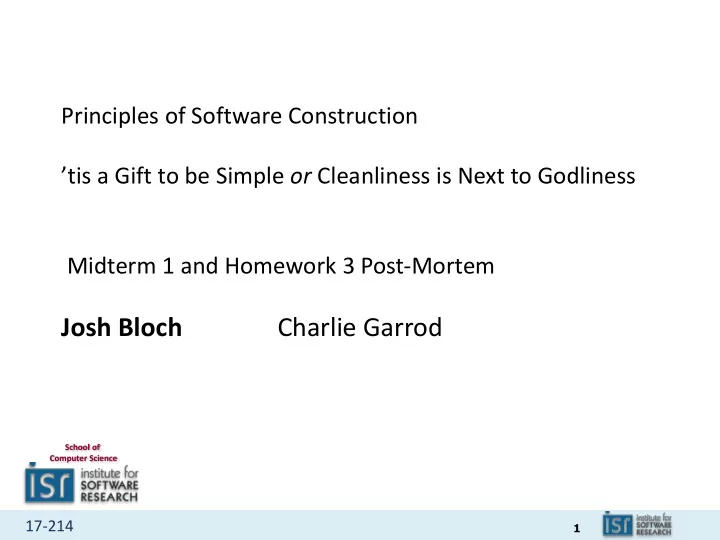

Principles of Software Construction ’tis a Gift to be Simple or Cleanliness is Next to Godliness Midterm 1 and Homework 3 Post-Mortem Josh Bloch Charlie Garrod School of Computer Science 17-214 1
Administrivia • Homework 4a due Thursday, 11:59 p.m. – Design review meeting is mandatory 17-214 2
Outline I. Midterm exam post-mortem II. Permutation generator post-mortem III. Cryptarithm post-mortem 17-214 3
Midterm exam results 17-214 4
Anyone know a simpler expression for this? if (myDog.hasFleas()) { return true; } else { return false; } 17-214 5
Hint: it’s not this return myDog.hasFleas() ? true : false; 17-214 6
Please do it this way from now on We reserve the right to deduct points if you don’t return myDog.hasFleas(); 17-214 7
DnaStrand should be immutable • Much safer – value can’t change underneath you • Trivial to use concurrently – no synchronization necessary • More efficient – can share instances • Always make simple value classes immutable! 17-214 8
What’s the best representation for a base? 17-214 9
What’s the best internal representation for a strand? 17-214 10
In a real-world setting, performance concerns might intrude • The human genome has about 3 billion base pairs – Would take up 24 GB with our current representation – But each base pair has only 2 bits of actual information – So you could cut this down by a factor of 16 • This implies a bit-vector representation – Strand would be represented as an array of (say) int – Where each int represents 16 bases • But you don’t do this sort of thing until you know you have to – Avoid premature optimization • It would have been wrong to do this for the exam 17-214 11
What are best input types for constructor (or factory)? 17-214 12
A good, basic solution – Base enum (1/4) 17-214 13
A good, basic solution – field and constructor (2/4) 17-214 14
A good, basic solution – Object methods (3/4) 17-214 15
A good, basic solution – complementarity methods (4/4) 17-214 16
API is good – client code is pretty 17-214 17
Why is this solution ¼ the length of many we received? 17-214 18
Why is this solution ¼ the length of many we received? • Good choice of internal representation – Fighting with representation adds verbosity • Makes good use of the facilities provided for us by the platform • Makes good use of itself – Code reuse vs. copy-and-paste 17-214 19
Outline I. Midterm exam post-mortem II. Permutation generator post-mortem III. Cryptarithm post-mortem 17-214 20
Design comparison for permutation generator • Command pattern – Easy to code – Reasonably pretty to use: PermGen.doForAllPermutations(list, (perm) -> { if (isSatisfactory(perm)) doSomethingWith(perm); }); • Iterator pattern – Tricky to code because algorithm is recursive and Java lacks generators – Really pretty to use because it works with for -each loop for (List<Foo> perm : Permutations.of(list)) if (isSatisfactory(perm)) doSomethingWith(perm); • Performance is similar 17-214 21
A complete (!), general-purpose permutation generator using the command pattern 17-214 22
How do you test a permutation generator? Make a list of items to permute (consecutive integers do nicely) For each permutation of the list { Check that it’s actually a permutation of the list Check that we haven’t seen it yet Put it in the set of permutations that we have seen } Check that the set of permutations we’ve seen has right size (n!) Do this for all reasonable values of n, and you’re done! 17-214 23
And now, in code – this is the whole thing! 17-214 24
Pros and cons of exhaustive testing • Pros and cons of exhaustive testing + Gives you “absolute assurance” that the unit works + Exhaustive tests can be short and elegant + You don’t have to worry about what to test − Rarely feasible; Infeasible for: • Nondeterministic code, including most concurrent code • Large state spaces • If you can test exhaustively, do! • If not, you can often approximate it with random testing 17-214 25
Outline • Midterm exam post-mortem • Permutation generator post-mortem • Cryptarithm post-mortem – Cryptarithm class (6 slides) – CryptarithmWordExpression (2 slides) – Main program (1 slide) 17-214 26
Cryptarithm class (1/6) – fields 17-214 27
Cryptarithm class (2/6) – constructor / parser Sample input argument: ["send", "+", "more", "=", "money"] 17-214 28
Cryptarithm class (3/6) – word parser 17-214 29
Cryptarithm class (4/6) – operator parser 17-214 30
Cryptarithm class (5/6) – solver 17-214 31
Cryptarithm class (6/6) – solver helper functions 17-214 32
CryptarithmExpressionContext Naïve version; solves 10-digit cryptarithms in about 1 s. 17-214 33
CryptarithmWordExpression Naïve version; solves 10-digit cryptarithms in about 1 s. 17-214 34
Cryptarithm solver command line program 17-214 35
Conclusion • Good habits really matter – “The way to write a perfect program is to make yourself a perfect programmer and then just program naturally.” – Watts S. Humphrey, 1994 • Don’t just hack it up and say you’ll fix it later – You probably won’t – but you will get into the habit of just hacking it up • Representations matter! Choose carefully. – If your code is getting ugly, step back and rethink it – “A week of coding can often save a whole hour of thought.” • Not enough to be merely correct; code must be clearly correct – Try to avoid nearly correct. 17-214 36
Recommend
More recommend